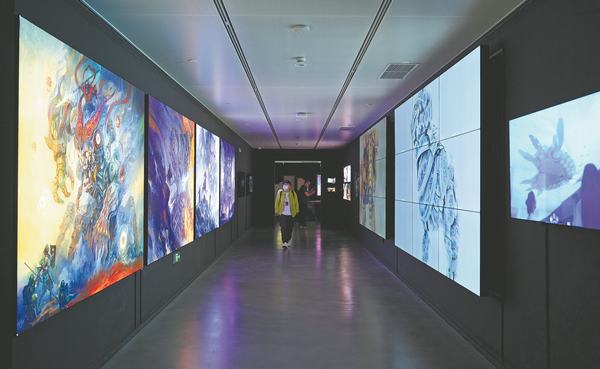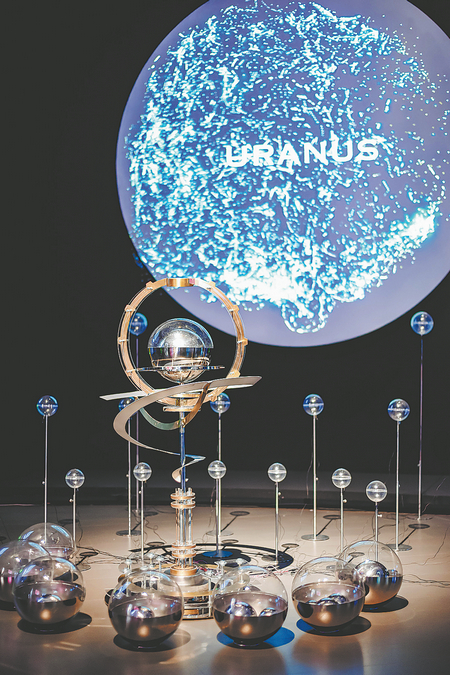
The Big Picture of Bits and Bytes

Digital art works on show open up people's eyes and minds to envisage the future.CHINA DAILY
Digital art show explores multisensory dimension to inspire enthusiasm for the future, Lin Qi reports.
Whether embraced or feared, the emerging reality deeply embedded in digital technology is rapidly reshaping lives, and advances toward a future of even greater possibilities empowered by developments such as AI, big data and the metaverse.
The ever-evolving technological scene is blurring the boundaries between disciplines and inspiring people to create change in the current world, as well as to imagine all the worlds possible in the years to come.
This has motivated Hangzhou's China Academy of Art in Zhejiang province to mount Hello World: Digital Art China, an exhibition that will run at its art museum until June 3. The show navigates the influence of digital technology on art and design since the start of the century, as well as cross-disciplinary education blending art, design and technology at universities.
Every exhibit is chosen to enrich the audience's experience of the world and their vision of future existence, says Gao Shiming, president of the China Academy of Art, and takes visitors from the origins of Chinese civilization to the frontiers of space exploration, the making of the metaverse and future cities equipped with intelligent networking.
"Art is essentially a channel to all possible worlds that can be imagined … and the evolution of digital technology greatly empowers people to envisage and realize possible worlds," Gao says.
"A lot of the work at the exhibition is projected onto digital screens, which are like windows that open up eyes and minds to these visions of the future, and which tell people that everyone, not only artists, designers and scientists, can contribute to the process."

Geometry of Emotions, an interaction work and collaboration of artists, mathematicians and psychologists.CHINA DAILY
Chen Yan, a member of the exhibition's organization committee and director of the CAA AI Center, says that they set up an official website for submissions about a year ago and by October, they had received 12,000 entries. "As a result, we have also been able to build a database of a considerable size of digital art works and creators, which is important to the national digital art scene," he says.
Chen adds that they invited several digital artists of repute to show at the exhibition, and that the work is divided into categories including computer generated images, digital videos, interactive design, artificial intelligence, augmented reality, virtual reality and mixed reality.
"Every visitor will be able to see how digital technology has changed our lives and how it will shape our future," he says.
The exhibition takes people to the country's past, as well as to the forefront of space exploration, creating a link between the past, present and future at a single venue.
For example, a mixed-reality piece presented by the China Media Group is an immersive experience allowing visitors to take a virtual journey via an online platform called the CMG Meta Museum, where it is possible to tour reconstructions of 10 archaeological sites key to China's over 5,000 years of civilization in avatar form.

Audiences exchange with Syer, a digital human developed by Yu Zhen.CHINA DAILY
Visual effects firm Morevfx has submitted a video featuring images and trailers for The Wandering Earth 2, the epic sci-fi film adaptation of Liu Cixin's novel released last year, which is designed to inspire enthusiasm for China's foray into aerospace exploration.
Dozens of pieces on display reflect the guochao (Chinese fashion) trend of recent years in which elements of traditional arts are incorporated in creative products as a means of keeping cultural heritage alive. Meanwhile, a team of artists from the Guangzhou Academy of Fine Arts have created Beijing Opera. Impression, a piece that hails the dynamism and rhythm of Peking Opera stunts by rendering the movements of the performers as flows of particles via computer.
Chen Qinzhen, a member of the production team, says the exhibit is also connected to software that can capture the audience's movements, digitize them and incorporate them into the flow of particles, so that visitors will experience a sense of interaction.

Cosmo Symphony, an installation by Shi Rong on show.CHINA DAILY
Other exhibits, such as Syer the Posthuman, a digital human presented by Yu Zhen, the exhibition's curator and who is an artist and architect, are also interactive. The audience can talk to the digital human, which appears on a huge screen supported by a metallic arm, via microphone. Yu and his team began developing a digital being in 2020. Syer is the third iteration in this exploration.
"Syer is alive, just like us. No one can predict what it will do next," Yu says. "How its face will look, its moods, its undertones when speaking … will all correspond to the way the person talking to it acts. … It is self-evolving."
Pei Muyan, who currently studies at the California Institute of the Arts in Valencia, California, says that digital art allows people to cross culture and language barriers. Her entry, The Letter of the Ocean, shows the typing of a letter about the countries and regions she has visited, recorded not in any of the languages of the world, but using footage of the sea.
"It seems that the sea isolates continents and islands, but I would rather see the ocean as connecting people from different cultures and allowing us to reach one another. Everyone can get a message from this letter of the sea, and I believe humanity has shared feelings, despite our differences."
She says that this is the case with digital art, which helps people share their experience, knowledge and emotions more easily, and opens up discussions, in different social and cultural contexts, of new possibilities for the world.